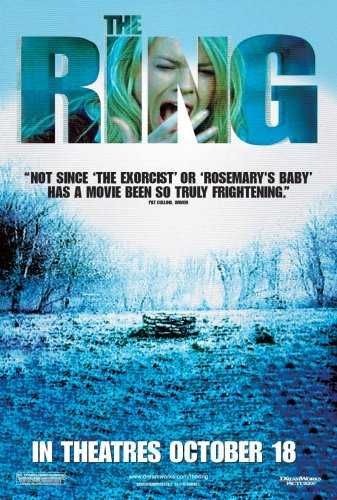Plot Summary:
 |
| http://www.impawards.com/2002/posters/ring_ver3.jpg |
An investigative journalist by the name of Rachel Keller follows a story about a cursed videotape, supposedly responsible for killing her niece as well as several of her friends. Those who watch the contents of this videotape (after receiving a phone call) have exactly seven days to live. After Rachel's son watches the footage on the cursed tape, she must now race against time to find out the history behind the contests on the video and hopefully, a solution to rid both her and her child of the wretched curse.
This remake/interpretation, was not that bad. Although not directly following the narrative path of Hideo Nakata's 1998 original, this film did very little to disappoint, bringing fresh and imaginative additions to the plot, answered some interesting narrative points not explored in the original and still ended up with the same conclusion, however, there were still a number of flaws and interesting factors I feel have to be brought forth about this remake/interpretation.
- Insects - insects were persistently used to symbolise death in this film, subtly placed to develop the narrative.
- Length - like many remakes before and after it, this remake interpretation took a staggering hour and fifty minutes to reach a conclusive point, making me loose interest as well as enthusiasm after a certain point
- Blue - the film had a massive overuse of a blue scope, everything had a sort of blue-ish appearance to it, however, these colour values were saturated well showing some indication of a grey-scale.
- Character involvement - certain character roles in this remake/interpretation were developed to a greater degree, unlike some in the 1998 original such as; the murdered girl, her father and the investigative reporters son, making the story structure as a whole feel more convincing and thorough.
- Performance - the acting in this remake/interpretation was very convincing and nowhere near as rusty or dull as the 1998 original, particularly the role of the deceased girl's father, performed beautifully by Brian Cox.
- Setting - this remake/interpretation drifted from time to time when focusing on the setting. Key areas such as the cabin in the woods, the island and the journalistic facilities were all present in this film, however, there are several other locations relevant to particular plot points in this remake/interpretation that are not in the original.
- Colour - this remake/interpretation did fantastic in terms of colour because there were barely any high value colours noticeable/present and there was constant saturation, although not directly grey, this remake/interpretation did very well to adhere to the colour used in Japanese directed horror.
- Lighting - three point lighting was constantly used in this remake/interpenetration as well as few uses of high contrast lighting, following the unique characteristics of Japanese horror and showing great adherence as well as influence to the 1998 original.
- Composition - this compositional value of this remake/interpretation was not half bad. The shapes in this remake/interpretation were non-conflicting and the depth of field rarely strayed from an infinite field of vision, therefore, following the characteristics of Japanese directed horror. The scaling was realistic and camera work, although using some of the favoured American long distance and establishing shots/distances, this remake/interpretation made some use of the higher and lower camera heights, the side camera angle and close distance shots, thus, adhering to the unique characteristics of Japanese directed horror.
 |
| http://cineawesome.com/wp-content/uploads/2011/11/152m3qg9858786.png |
Despite this positive feedback, this remake interpretation did have its own fair share of negative comments, "by the time "The Ring" gets around to delivering its big surprise payoff, it's too little--too late. The horror feels likes it's already over when another character dies without putting up a fight or even running for the shear joy of providing an appropriate chase scene. The audience is even spared the sight of his supposedly gruesome corpse because, either the special effects make-up team couldn't get it right, or because the filmmakers ran out of money. Either way the movie is a dog from start to finish, with enough genre inconsistencies and plot holes to make it a textbook example of borrowing from too many divergent horror films to get anything right" (Smithey, 2009)
However, the positive feedback proves to be more dominant with reviewers, seeing this remake/interpretation flawed but still a success, "as a concept, it's flawed. As a remake, it's good. As modern horror, it's a firecracker up the genre's ass. Make sure you take a date - this is so spooky you can pull the 'yawning arm over shoulder' move and get away with it." (Dinning, 2006)
Conclusion:
 |
| http://www.darkhorizons.com/assets/0011/7355/ring_article.jpg?1272385543 |
Director Gore Verbinski did very well in visualising his interpretation of Hideo Nakata's 1998 original, making interesting adjustments as well as adhering to the majority of unique characteristics of Japanese horror. Although it was not regraded as highly in terms of critical acclaim, this remake/interpretation did much better in depicting that of its original source than any of the four remakes/interpretations which I have investigated. Although not a newly developed characteristic of Japanese horror, this remake/interpretation has shown me that saturation can remain in the colours displayed to the audience, however, changing the lower valued grey to anther colour does not detract from the overall aesthetic depicted in Japanese directed horror.
References:
http://www.film4.com/reviews/2002/the-ring
http://www.colesmithey.com/capsules/2009/01/the-ring.html
http://www.empireonline.com/reviews/ReviewComplete.asp?FID=8750
+The+Ring+Opt+3.png)
No comments:
Post a Comment